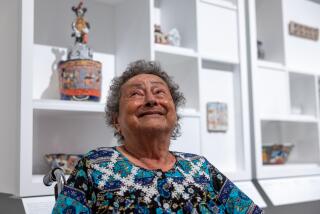ART REVIEW : A Portrait Gallery of Mexican Artists
The latest entry in the “Artes de Mexico” festival saturating the city is USC’s exhibition “Capturing the Spirit: Portraits of Contemporary Mexican Artists.” Circulated by the Smithsonian Institution, it is less an art exhibition than a kind of pop-up primer intended to familiarize the unfamiliar with the faces of 40 of Mexico’s leading artists.
The visage of Nobel laureate Octavio Paz looms before the Aztec stone calendar literary and leonine, seasoned and cosmopolitan. Potter Delores Porras stands barefoot in the dust, rooted to the land like a dark tree trunk. Classical music conductor Enrique Diemeke strikes a dramatic pose in his tux. Weaver Herlinda Gutierrez included her son in the picture along with handsome traditional-style hangings in the background.
There is constant and kaleidoscopic contrast between theater folk, folk artists, architects, painters, sculptors and journalists. The portraits were taken by Carole Patterson. Information about her in gallery literature is rather sparse. She’s shown similar work around the country and has been reproduced in the New York Times, Philadelphia Inquirer and American Poetry Review.
Clearly it is not the point of the exhibition to focus on the aesthetic quality of Patterson’s work. Basically, it is professional journalism that occasionally outstrips itself. There is poignancy about representing the late Rufino Tamayo by the now-empty white lawn chairs in his garden. Painter Abel Quezada is represented in a nice white-on-white composition enlivened by a hammock that cuts athwart the composition. On the whole, the emphasis is not on the photographer but on the theme of the exhibition--distilling the spirit of Mexico’s art community.
Is it possible to do that in portrait photographs? Well, it might be a revelation to anyone previously inclined to stereotype Mexican artists. There is a regular Noah’s ark range of human types among them. British-born Surrealist Leonora Carrington’s impish septuagenarian visage contrasts with the laughing brown face of folk carver Manuel Jimenez Ramirez . The romantic, bearded good looks of photographer Pablo Ortiz Monasterio play off the avuncular professorial cool of architect Pedro Ramirez Vazquez .
Somehow, the news that Mexico’s artists include light and dark-skinned citizens, boors and brooders, men and women, egoists and saints seems a trifle too self-evident.
Didactic wall labels tell us that Mexican artists find certain psychological characteristics and social circumstances germane to their creative lives. They include Catholicism, the country’s paradoxical one-party democratic system, machismo, a preoccupation with myth, magic and death.
It takes a good bit of doing to derive hints of these characteristics from the photographs, and in the attempt one is unwittingly invited into stereotype and further paradox. Maybe the answer might have been to give us art instead of artists. Death is, for example, a constant theme in the work of the great photographer Manuel Alvarez Bravo, but in his portrait he looks like a lovely, gentle octogenarian.
Accompanying the photo exhibition is a work by Marta Palau--a “ritual installation” consisting of two spectral icons made of earth, bark, fiber and paint. Standing on a bed of dead leaves they leave no question of their absorption in myth and sorcery. Trying to draw such aesthetic conclusions from photographic portraiture intended as information and not art, however, is much dicier business.
Besides, the exhibition is about artists, not art; an exhibition that always seems to want to be something else--a book.
Sure enough, there is a book related to the show called “Out of the Volcano.” It includes Patterson’s photographs and a text by Margaret Sayles Peden , a translator and critic of contemporary Latin American literature. Here, the goal of providing a basic guide to Mexico’s cultural community finds its appropriate form.
Peden’s text has some of the laundered blandness and breathless enthusiasm of an author working with heartfelt good intentions. It also has helpful entry-level information and insights basic to understanding how culture works in Mexico. Perhaps the most germane--and most enviable--is the way that Mexican artists are far more organically interwoven with one another and with the larger culture than here in the more specialized States.
In Mexico, she points out, artists are appointed to governmental and ambassadorial posts. A novelist like Carlos Fuentes becomes a staunch supporter of an artist like Jose Luis Cuevas . Sculptor Francisco Zuniga makes a monumental public sculpture in homage to the revered poem, “Beloved Land.” Abstract painters have libraries worthy of philosophers and actors collect art as a private passion.
It happens here too, but it is rarer. It seems Mexico follows more closely on a European model we have yet to attain.
USC Fisher Gallery, 823 Exposition Blvd., to Dec. 14. Closed Sat.-Sun and Thanksgiving. (213) 743-2799.
More to Read
The biggest entertainment stories
Get our big stories about Hollywood, film, television, music, arts, culture and more right in your inbox as soon as they publish.
You may occasionally receive promotional content from the Los Angeles Times.










